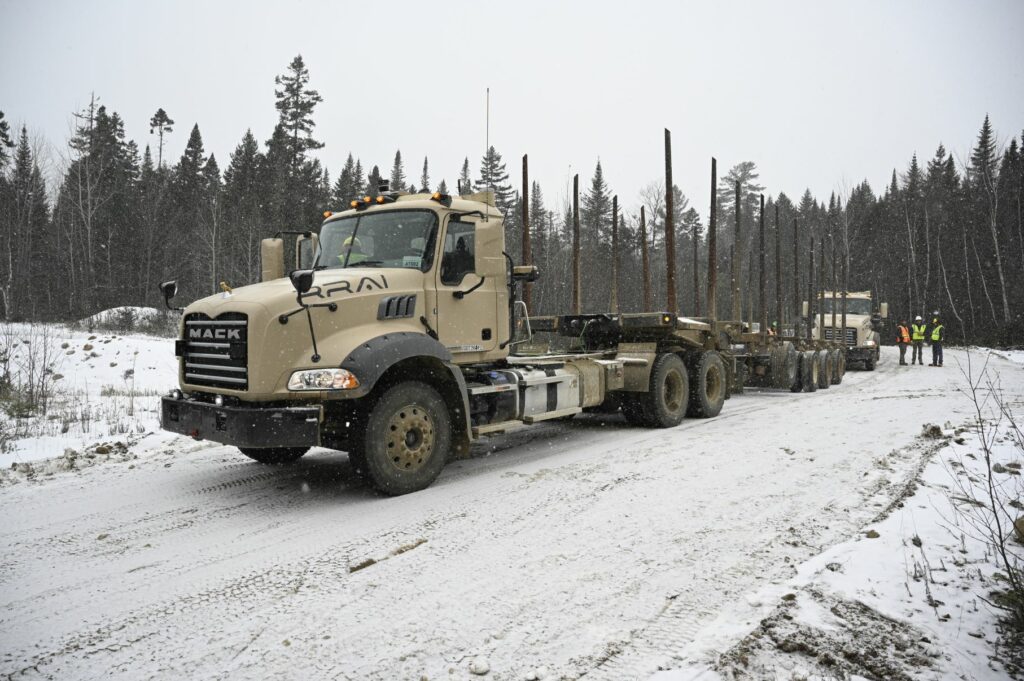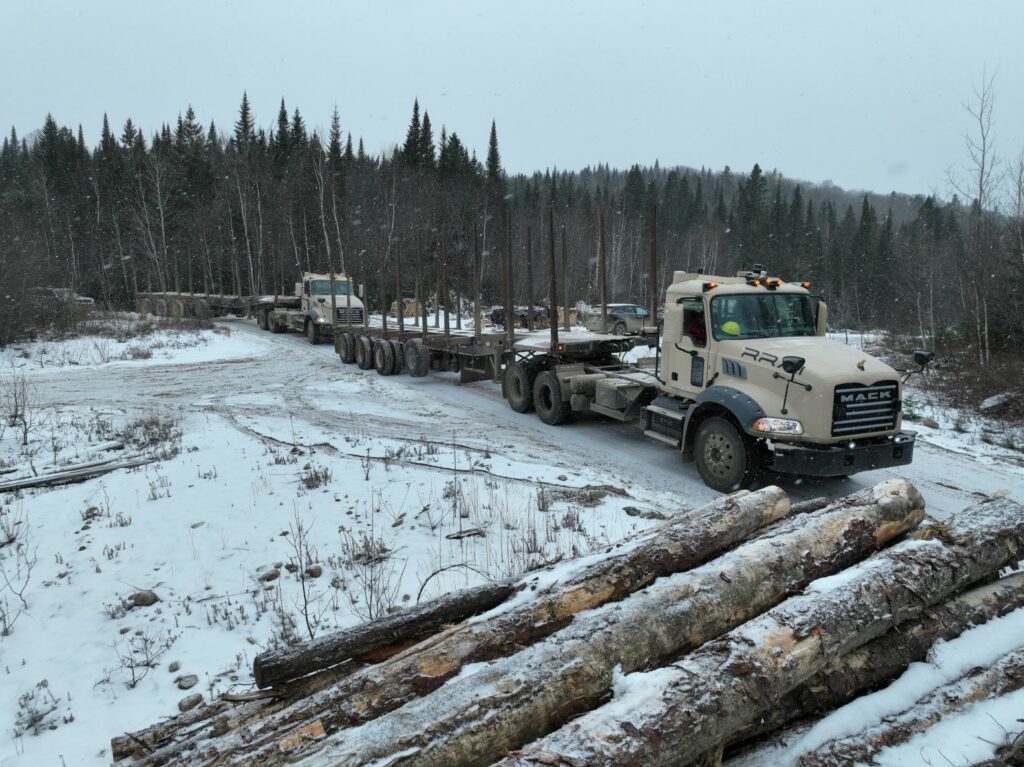Autonomous trucks cutting a path in forestry sector
In an untamed Quebec forest, a Canada lynx watches curiously from the bush as a platoon of Mack Granite logging trucks, one of them operated autonomously, passes by on a remote logging road. Meanwhile in Maryland, engineers from Robotic Research Autonomous Industries (RRAI) watch the lynx on screens set up to monitor the performance of the autonomous truck platoons serving a Resolute Forest Products facility.
This is the rugged Canadian wilderness, where forestry trucks encounter some of the toughest conditions imaginable. And this, according to Robotic Research, is the perfect environment for the near-term automation of commercial trucking.

Gabe Sganga is head of commercial growth for RRAI. The company got its start in automation more than 20 years ago, before anyone in the commercial trucking sector was even thinking about automating heavy trucks. Robotic’s origins involved working with the U.S. Department of Defense to develop automated military vehicles. In recent years, the company realized its AutoDrive self-driving platform had commercial potential as well.
“The leadership team at the company looked at each other and said, ‘We’ve built an end-to-end technology stack that’s really focused on off-road. What are some commercial uses for this technology?’ And one of the greatest commercial use cases that we found was forestry, in areas where you have a lack of human resources or where they’re incredibly remote and it’s just hard to get people to do the jobs,” Sganga said in an interview with TruckNews.com.
While much of the focus on the automation of trucking has focused on the middle mile, RRAI felt the greatest potential for early success would be off-road.
Carving a path off-road
“From a regulatory perspective, that’s a pretty scary place to be for the next few years,” Sganga said of middle-mile applications. “We really want to focus on places where autonomy can make a difference in the immediate term.”
Meanwhile, FPInnovations, a Quebec-based research body focused on the forestry sector, was working with members to address challenges including the lack of professional log haulers. It connected with RRAI to embark on a project that would test autonomous truck platoons on off-highway logging routes to get logs from the forest to the mill safely and efficiently.
“Our mission is to help the industry be more competitive and to help the transformation of the industry as well,” Stephane Renou, president and CEO of FPInnovations, said of the work. “This project actually fulfilled both goals.”
Up to 40% of the cost of wood can be traced to transport costs, he pointed out. And forestry companies are struggling to find drivers to haul product in remote areas on rough roads. “It has become a bottleneck to be able to transport that biomass from the north to the south and to the mills efficiently.”
Renou said FPInnovations initially felt going straight to full autonomy was “a step too far.” But he added, “When we start looking at those concepts of platooning, basically getting another truck to follow the lead truck, then it becomes interesting.”
A safety driver is at all times in the autonomously operated truck.
Perfect for platooning
The lead truck in a platoon is piloted by a human driver who establishes a breadcrumb trail, so to speak, for the subsequent trucks to follow, even where there are no paved roads. The following units (one in the initial tests, but more are possible) are equipped with lidar and other technologies allowing them to follow the lead truck without a human driver. FPInnovations and RRAI successfully concluded benchmark testing in July and continue to operate the AutoDrive-equipped Mack Granite platoons today.
But Robotic Research didn’t choose to start out in an off-road environment because it would be easy.
“We think the harder challenge is operating in the really multidimensional, undefined spaces where there are no paved roads, and in some cases there aren’t even roads,” Sganga said. “If you can do that well and operate in the Canadian wilderness, and you can operate in the Permian Basin of Texas where temperatures can approach 115 F, 120 F [49 C] in the summer, then you can do just about anything.”
The temperatures, of course, are quite different in Northern Quebec, and so too are the road conditions. But Sganga said the company must be able to handle all weather and road conditions.
“If a vehicle that’s manually operated can handle the weather, then we have to be able to do the same,” Sganga said. “So far AutoDrive has done a fantastic job. From a perception and path planning perspective, we’re doing fantastic.”
Another challenge encountered in forestry that wouldn’t be an issue in paved cities is the roads themselves are constantly evolving. The forestry roads are recreated every couple of years, and can even experience changes day to day based on the traffic they encounter.

Changing road conditions
“The condition of the road will change monthly or weekly,” Renou explained. “They are often shared roads between different operators for different things. So a road that is great one day won’t be that good three weeks later, because somebody passed with a heavier load and created pot holes and challenges. That’s why a system that constantly maps out not only the structure of the road, but everything that can happen in between, is super important.”
The off-road market may be seen by some as a stepping stone to the more widespread automation of commercial trucking. But it presents a massive opportunity in its own right, Sganga said, noting the market potential for off-road applications is between US$8 and $15 billion.
“The addressable market for middle mile is much bigger,” he acknowledged. “But when you hear from FPInnovations and other partners and customers, they need autonomy now. So, we’re really focused on that space because these are spaces where autonomy can go operate today.”
He said the units being tested with FPInnovations today will be scalable and production-ready in “the next couple of years.”
Retrofitting tech
The AutoDrive system can be retrofit on any brand of Class 8 truck. Robotic Research chose Mack for this project because it’s familiar with the OEM through their work together on military vehicles and the two companies have a good working relationship. When RRAI comes to market, it plans to offer its platform as a subscription service.
“The subscription services provides it at a firm, fixed, predictable price,” Sganga said.
Both RRAI and FPInnovations also envision a day when full, single-truck automation is possible on logging roads, but Renou said platooning offers a good opportunity to become familiar with automated truck technology, its potential and limitations.
“For us, platooning is actually the way to get everybody educated,” he said. “It lays out the key blocks that need to be there to move forward.”
“We can run single-vehicle autonomy today,” Sganga added. “But we think this is a great interim step that gets a meaningful return on investment for customers and end users in a nearer-term fashion. Single-vehicle autonomy is here, it’s coming to the masses, and I think it’s going to impact spaces such as the forestry industry first, because of the controlled nature of the operating domain and the off-road capability of the technology. But platooning doesn’t make sense for other operations, so we’ll be developing both.”
Supply chain disruption
Today, the opportunity to run three trucks using one driver is appealing to forestry companies struggling to find drivers. Other industries, such as mining, are closely watching the project to see if it can be applied to their own off-road applications, Renou said. He’s also aware that the technology could disrupt the entire forestry supply chain, which today is heavily reliant on owner-operators and small log-hauling contractor fleets.
“The cost structure will change, the way of operating will change,” Renou admitted. “It will disrupt the business model. And if you extend it to the mill yards, that is probably one of the spots in the forestry industry where you have the least efficient operation right now.”
But Sganga added a human element will still be required even as automation is ramped up.
“In the near term, I don’t see a world where robots are out doing these things alone,” he said. “We believe in guarded autonomy where in the future, the FPInnovation partners who operate our vehicles will have a command center where they’ll be monitoring the vehicles as they run. And if the vehicle encounters something in a yard, or on a trail, they’ll get an alert and they’ll pull that up, look at it and say, ‘That’s something I need to intervene in.’ They’ll grab a joystick, they’ll maneuver the truck around if it’s something that the truck just can’t figure out. We’ll take those learnings back and improve the product.”
And they just may see some wildlife while they’re at it.
Have your say
This is a moderated forum. Comments will no longer be published unless they are accompanied by a first and last name and a verifiable email address. (Today's Trucking will not publish or share the email address.) Profane language and content deemed to be libelous, racist, or threatening in nature will not be published under any circumstances.
-
Are you related to Nelson? Rural resentment will cause several of these trucks and other autonomous equipment to have serious accidents, bet on it.
-
The International Labor Organization research says that in the forest sector there is an estimated 33 million jobs worldwide. Yes one could say it’s about the money indeed.
Verry good article ! Thank you for thé information ,thé d’iAds in thé bush will need same improvisé which is not a big challenge and AfterShip thé l’iAds are more standard weight thé New way off legging transport can begin! Good work!
Speaking from past experience . . .
In Defence of Humane Job Security
Ask the various independents and Truck Loggers Associations where they stand in defence of their future employment, and if they have any “language” in their Union contracts that are “iron-clad” to protect them from future “technological change”.
As a 30 year Union activist, I found that “technological change” language gave the individual members a deluded sense of security and protection, but as change happened over the years, there never was compensation for loss of hours or employees. The language is very weak.
The profiteering forest industry has already engrained into the driver’s psyche, that the reason for autonomous technological change is on account of the shortage of operators and/or safety concerns.
It’s just pure greed and more financial gain at the very top by the selected few.
The worker’s jobs are being liquidated at the same time the speed of the forest industry intends on removing the forests at an ever faster and faster production rate with less man-power.
And no one will be the wiser, or benefit from the pure greed.
forestry was never about the jobs, never has been, it is about the profits,follow the money to the degradation of the environment and collateral damages and you will find logging’s raison d’etre